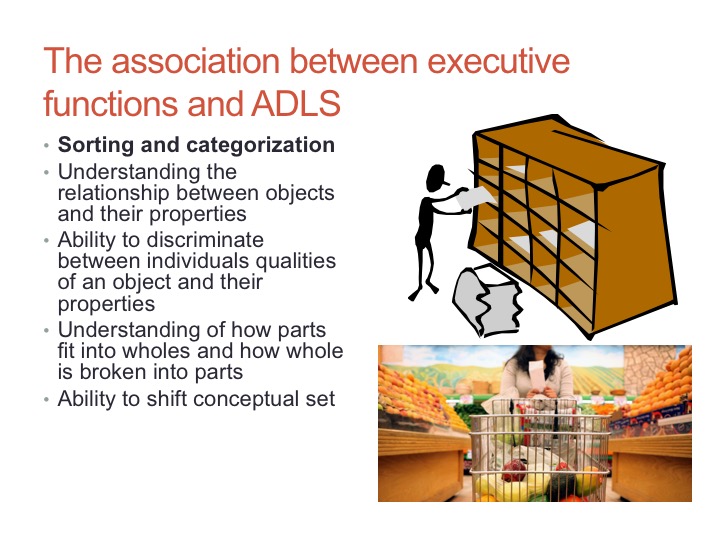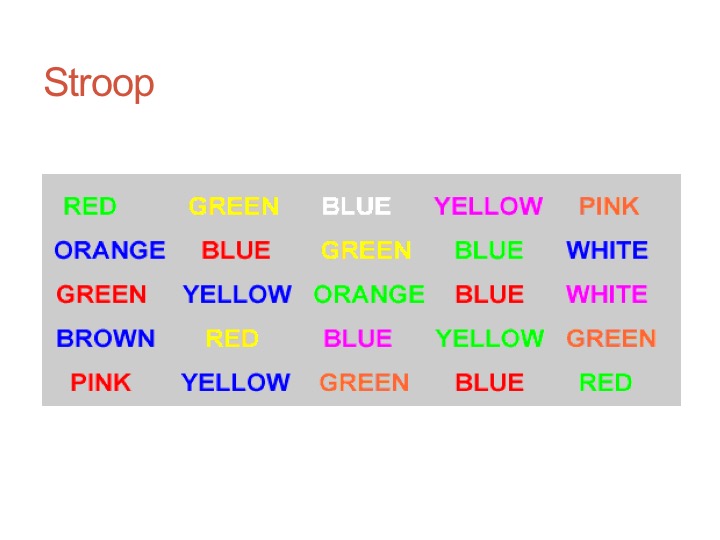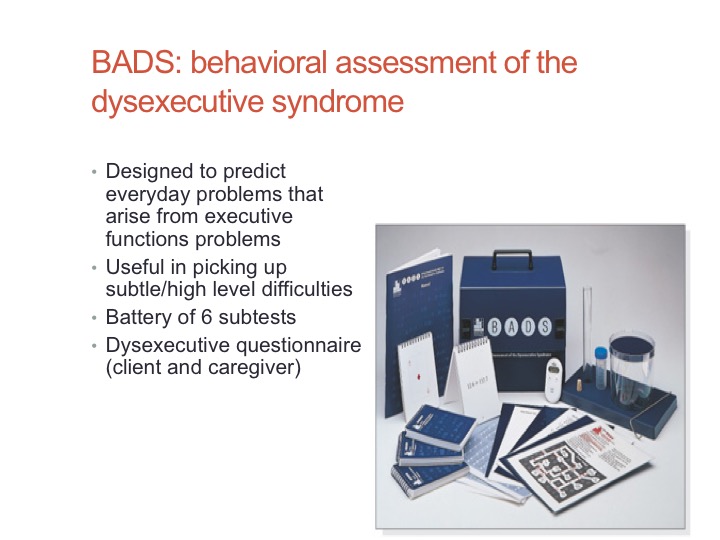Yael: I would like to present today about motor executive functioning and it relates to everyday life activities. We will also discuss some of the contemporary and traditional assessments and will conclude with some more innovative or current treatments related to executive functions.
What Are Executive Functions?
Executive functions are defined as brain functions used to manage attention, emotion, and pursuit of goals. They emerge during preschool years and do not fully mature until early adulthood. Some research shows that executive function skills are more predictive of school success than actual IQ score. Executive functions are cognitive control abilities that depend on the prefrontal cortex. It is the executive director of all of our brain functions. Therefore, the ability to engage in independent, purposeful, and self-directed behavior are dependent on executive functioning (Lezak, 1995).
We can see deficits in executive functions in one or more of the following areas: volition, planning, purposive actions, self-awareness, and self-monitoring (Lezak, Howieson, & Loring, 2004). Executive functions will be at the top of the hierarchy because they are very important skills that can actually manage and direct all the other cognitive functions. Executive functions can be divided into two main segments.
Core Executive Functions:
Higher Order Executive Functions:
The first is core executive functions and the second is the higher order executive functions. In the core, there is inhibitory control, which is actually our self control. When we want to make a quick decision, which is based on intuition or other decision processes, but we know that maybe it is not the right decision or choice, we have to inhibit our immediate response. Working memory is keeping one or two pieces of information and sometimes even more at the same time in our brain. Cognitive flexibility is the other component of core executive functions where you have to be flexible about decisions and choices. For example, if you walked in the street to go to the supermarket, but someone called you to ask you information about school, it is important to be able to answer the question. However, you then need to go back to your previous task of going shopping. All of these are core executive functions.
Then, we have higher order executive functions, which relate to problem solving. For example, what would you do if you were supposed to go to work for a scheduled appointment at 9:30 in the morning, however, your car is not turning on. What would you do? Would you call you neighbor immediately to come and help? Would you ask someone in the street to help you with the battery? Would you just leave the car parked in the street where it is not actually allowed to be parked? There are many different answers to different problems, and you have to choose the one that will be the best choice. Executive functions actually help us in making judgments and solving problems. Reasoning is another component of the higher order executive function because we have to reason and come to the right conclusion. Sometimes getting some pieces of information are not necessarily given to you directly. You have to reason about them and to decide what they are. We have deductive reasoning, inductive reasoning, and then planning. These are things like planning our day, planning how to study for a test, planning what to take for lunch today at work, etc. Planning can range from something very simple or more complicated.
The important thing is that all of these components, which I just spoke about, work together. We have the core executive functions and then we have the higher order executive functions, which actually coordinate how the different skills work together. I want to speak a little bit more in-depth about some of the components of executive function skills.
Executive Function Skills
One of the things I mentioned before is inhibitory control, self control, or effortful control. These are all the same concept with slightly different names. It is the ability to resist a strong inclination to do one thing, and instead, do what is most appropriate or needed. An example would be resisting acting on impulse. With the car example, the first thing I wanted to do was to call my neighbor to come and save me, but then, was this the most logical solution? Perhaps I could find a more efficient solution by staying focused on what is important using my selective or focused attention. There can be many distractions when you have to make a decision. I had to take my kids to school, and at the same time, remove the car from the side street where it should not be parked. So, I had to make a decision. What was more important at this point? I needed to find the solution and then stay focused on what I need to do. What are the action and the goals of my actions? You need to think before you act, resist temptation, and avoid jumping to conclusions. You resist acting on impulse and inhibit by using self-control to actually inhibit your first action and act in a logical way.
Cognitive flexibility is another important component because it is ability to change course when what you are doing is not working. As I said before, the first inclination I had was to call my neighbor to come and help me. However, I then thought that if I called him, it might take a lot of time. I would then be late to work, to my meeting and also my kids would be late to school. Using cognitive flexibility, my solution was to ask a person, who was parked behind me, to help me charge the battery and turn on my car.
Another executive function is to adapt to change easily. This is not so much about a course of solutions, but rather adapting change. What if you ask the person next to you to help you turn on the car, but he does not have the cables to connect the two batteries to one another. What do you do next? How do you adapt to this change? Do you stop another person? Do you just give up and call your neighbor? It is all about the ability to adapt and to adapt easily. Another example of adapting to change is going on summer vacation after school. All of these are changes and the way you adapt to them very much relates to cognitive flexibility and executive functions. This is the ability to take advantage and seize opportunities when they arise, even if it means changing course. Going back to my car example, if someone comes by, you asked one person, but he may not have the cables. Someone else drives by, you immediately stop them, and ask them about whether they have cables to connect the batteries. This is related to being able to think quickly and adapt to the situation. These were some examples of executive functions. Now I want to discuss the link between executive functions and activities of daily living.
Executive Function and ADLs
I put here two pictures.

Figure 1. Examples of categorization.
The first picture is of a person filing documents into cabinets; it can be the mailman or a secretary working in the office. This is an example of a categorization skill. Categorization skill is also related to flexibility, thinking to make decisions, and to deductive and inductive reasoning. Another example would be shopping. How does shopping relate to executive functions? You start with creating a shopping list. You have to think what you have, what you do not have, and sometimes you remember what you need to buy by actually thinking about all your things in the refrigerator. In order to make your shopping efficient and not too much of a time consuming activity, you go through the aisles and each section. In this picture, you can see that this person goes first into the fruit section. Now, if she did not have good executive functions, she may choose oranges, but then go to the dairy and get milk, and then go back to this section to buy some peaches. The efficient way would be to think ahead of what is needed in this section and collect all the items. Another example would be work activities. Think about all the challenges you may encounter at work. For example, what if you had a meeting at 10, but you already have another obligation at 10? What if there is an argument at work? What if you cannot get things done on time? Sorting and categorization are extremely important for these two activities.
Understanding the relationship between objects and their properties are important when you sort information, when you learn to know the world. This is the ability to discriminate between individuals, and the qualities of an object and their properties. When you create categorization and deduct and induct information in the example, you must understand that fruits belong to a certain category of foods and have certain qualities and properties. This is understanding how parts fit into the whole and how the whole is broken into parts.
In order to understand that oranges relate to citruses, you have to understand the different parts of the orange and how that relates to the family of the citruses. The ability to shift conceptual set is also related to flexibility. With shopping, if your list is not organized by concept and by section in the supermarket, you will not be efficient. What strategy would you use here to make your shopping easier? The best way to organize is to put things into categories such as cleaning, hygiene, fruits, dairy, et cetera.
I want to mention that there is a lot of research that shows that persons with mild cognitive injuries, like mild strokes or mild traumatic brain injuries, are often hospitalized, evaluated with a cognitive short screen, and are often not seen to have problems with memory or attention. However, they showed a very mild impairment in executive functions. These people often do not go to rehabilitation despite very mild executive functions impairment. A lot of these individuals reported years later that their marriage fell apart and some became unemployed. This example shows you that executive functions, even mildly impaired, can cause a lot of problems in main life roles. They may shop, clean their house, and manage their finances. However, when it comes to more complicated functions of daily life, such as employment, flexibility and abstract thinking are required. These are the places where people unfortunately sometimes fall apart. Therefore, executive functions are so important and should not be ignored even if you find mild cognitive impairment.
Assessments of Executive Functions
There are many assessments of executive functions. I want to share a few with you some standardized tests.
Today, I am going to speak more about the BADS and the Dalis-Kaplan, and I will describe a little bit about the Multiple Errands Test and the Weekly Calendar Planning Activity. These are all standardized tests and commercially available. For example, the Weekly Calendar Planning Activity is available through AOTA. Dalis-Kaplan is also published, and you can buy the BADS as well. The Multiple Errands Test is found in a lot of articles, but there is no book that you can buy.
The Multiple Errands Test
There is a lot of research that was done related to this test. On this test, people get errands to undertake in a place like a mall or the hospital. They have to adhere to the rules while performing the errands, and this test is taxing to executive functions because it requires flexibility, problem solving, prioritizing tasks over others, and abstract thinking. The Multiple Errands Test is very beneficial to assess everyday life executive functions from a more ecological perspective.
Weekly Calendar Planning Activity
The Weekly Calendar Planning Activity, by Joan Toglia (2009), is a very interesting test. It provides a more ecological valid assessment to assess executive functions. It can be performed in an environment such as an office or a clinic, as opposed to the Multiple Errands Test where you need the mall or a shop. People have to schedule different appointments throughout a week on a weekly calendar and have to adhere to rules. There are some issues relating to conflicts, and they have to solve some problems. It taps into abstract thinking, problem solving, flexible thinking, inhibition, and planning.
Stroop
The Stroop is a stand-alone test, which assesses attention and shifting attention, but it can be done as part of the Dalis-Kaplan.

Figure 2. Stroop.
In this test, you need to say the name of the ink without reading/saying the name. You have to inhibit your first response and say the color. For the first row as an example, you would say, "Green, yellow, white, pink, orange." It is not only inhibition but shifting concepts. Figure 3 shows another example.

Figure 3. This is another example of the Stroop.
In this one, you have to shift between saying the color and the word. This is again all part of executive functions. The Dalis-Kaplan Executive Functions Test has six subtests. Some of them are where you have to shift between letters and numbers. For example, instead of connecting all the numbers or all the letters (as in connect the dot activities), you have to connect and alternate between letter and number, so go from one to A, and then from A to two, from two to B, from B to three, et cetera, until you reach the number 16. It requires a lot of inhibition, shifting, and flexibility. Some other tests, like the Tower of Hanoi, relate to the Dalis-Kaplan. The Tower of Hanoi is a game where you have to move discs from one side to the other side with the fewest moves possible adhering to certain rules. It requires a lot of problem solving, keeping the rules clear, and inhibiting the first inclination of doing something.
BADS
The BADS is an assessment that is used a lot in occupational therapy. It is designed to predict everyday problems that arise from executive functions and picks up subtle high level difficulties. Like the D-Kaps, it has six subtests, and includes the Dysexecutive Questionnaire. This questionnaire provides self-report by the client and the caregiver about the client. Figure 4 shows a picture one of some of the materials.

Figure 4. Overview of the BADS.
One test involves action planning with a jar and a test tube. We put a cork within a tube, and the person needs to remove the cork out of this tube without using their hands or touching the tube. They can use also use the small piece of metal shown. The correct way to do it is to take out the lid with this piece of iron, fill the small tube with water, and once the cork floats to the top, then you can remove it.
